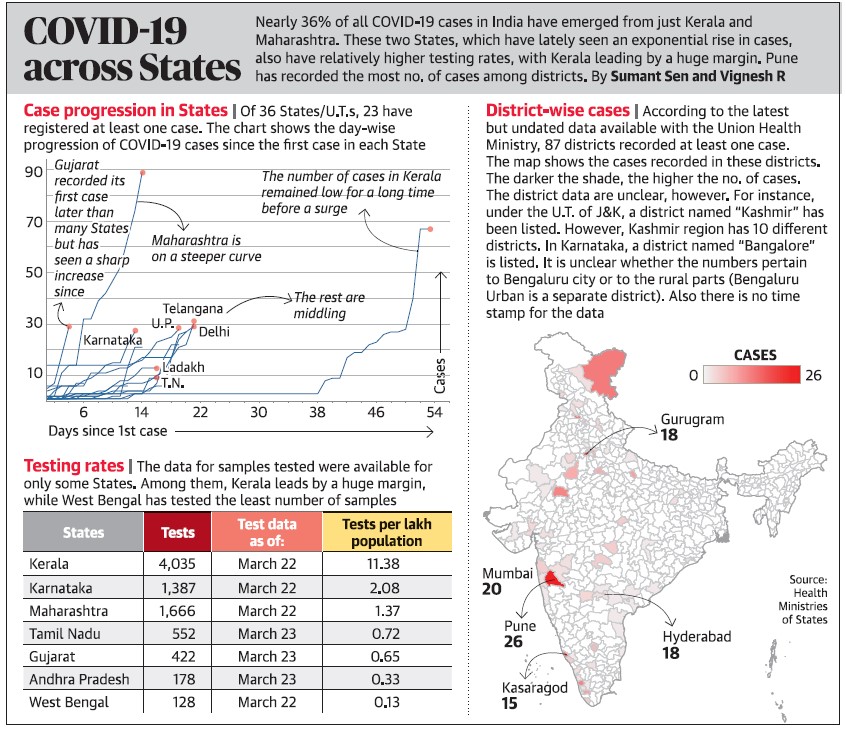Why in news?
Scaling up the precautionary measures to prevent the spread of COVID-19, the Karnataka government on 23rd March 2020, enforced “curfew-like” restrictions across the State from 24th March 2020, and will be in force till March 31 2020.
Details
- All public and private transport including Uber, Ola and autos will be off the road, while only essential services will be available across the State.
- The government, which had initially announced restrictions only in nine districts that had reported COVID-19 cases, later revised the order to cover the entire State.
- The government has enforced this under Epidemic Disease Act, 1981, making more stringent the guidelines put in place earlier.
Concerns in the State of Karnataka
- Karnataka State Government Medical Education Minister had expressed concern that despite declaration of lockdown, people were not completely confining themselves indoors.
- This would increase the chances of the spread of the virus, he observed, while pointing out that so far the State had reported 33 positive cases of COVID-19.
Measures taken by the Karnataka Government to control the COVID-19 Spread
- Only services and activities related to health, medicine, agriculture, and grocery would be allowed to operate in these districts, the Minister said.
- Similarly, industries would be asked to ensure that only 50% of their workforce were deployed for work.
- Government and private offices would be classified as “essential” and “non-essential” services depending upon the nature of operation and only those in the essential sector would be allowed to operate.
- The government had decided to strictly quarantine and test all those who had come in contact with the COVID-19 patients.
- It had been decided to test at least 200 people for a population of 10 lakh, he said.
- To facilitate this, licences would be granted to more number of government and private labs.
- The government would obtain the services of police in keeping a vigil on the C-category international travellers who have been home quarantined.
- The family members of such persons would also be quarantined and the police would be instructed to paste notices on their houses and also inform locals about it.
- A vigilance team comprising senior IAS officers had been formed to monitor the situation.

A Colonial Era Legislation: Epidemic Diseases Act, 1897
- One of India’s primary weapons against the Covid-19 pandemic is a 123-year-old colonial legislation, once used to imprison freedom fighters.
- The Epidemic Diseases Act of 1897 gives special powers to state governments.
- This law enables states to ban public gatherings, ask schools and large institutions to stop functioning, and issue advisories to companies to explore work-from-home models.
- It also gives the state a right to penalise media organisations spreading misinformation.
- The law is one of India’s last colonial-era legislations.
- The Act of 1897 was enacted on Feb. 4, 1897, to stop the spread of the bubonic plague outbreak in Bombay (now Mumbai).
- It gave the British government in India powers to restrict people from gathering in large numbers.
- The legislation simply states its objective as “better prevention of the spread of dangerous epidemic disease.”
- It also allows the central government to “take measures and prescribe regulations for the inspection of any ship or vessel leaving or arriving at any port in (the territories to which this Act extends).”
Has the Act been use Recently?
- The law was last used in 2018 to prevent the spread of cholera in a Gujarat village.
- It has also been invoked in cases of dengue and malaria in 2015 in Chandigarh and H1N1 influenza in 2009 in Pune.
Can the Act be Misused?
- While it helps contain epidemics, the Act can also be misused.
- In 1897, for instance, freedom fighter Bal Gangadhar Tilak was imprisoned for 18 months under this Act for his newspaper Kesari‘s anti-establishment coverage of the plague, according to The Indian Express newspaper.
- In a 2013 paper, medical scholars Binod K Patro, Jaya Prasad Tripathy, and Rashmi Kashyap questioned the efficacy of the Act, given its vague language and non-specific definitions.
- “Epidemic Act 1897 is silent on the definition of dangerous epidemic disease. Apart from isolation or quarantine measures, the Act is mum on the legal framework of availability and distribution of vaccine and drugs and implementation of response measures.
- There is no explicit reference pertaining to the ethical aspects or human rights principles during a response to an epidemic,” they observed.





